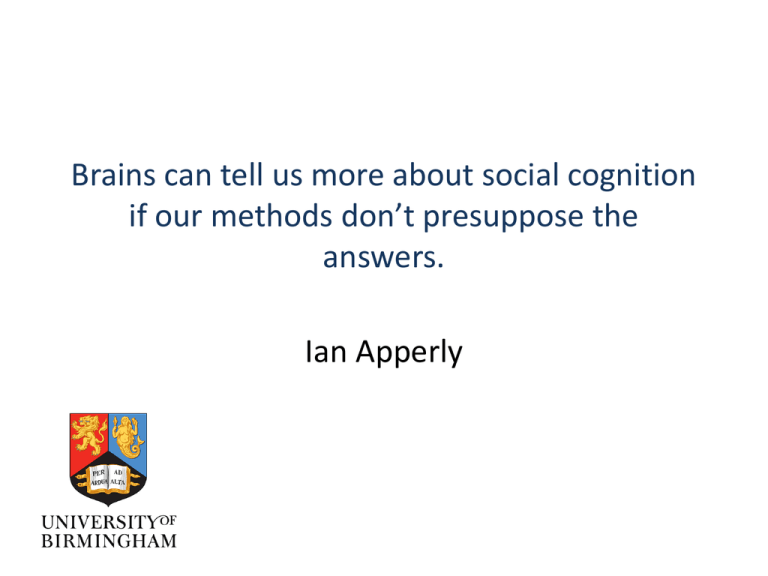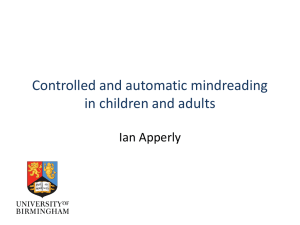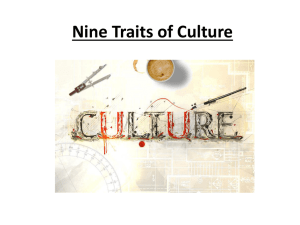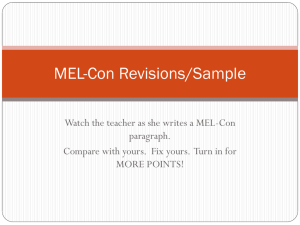Ian Apperly
advertisement

Brains can tell us more about social cognition if our methods don’t presuppose the answers. Ian Apperly Brains can tell us more about social cognition the cognitive basis of “theory of mind”if our methods don’t presuppose the answers. Ian Apperly What is “Theory of Mind”? • • “Folk psychology”, “Perspective-taking”, “Social cognition” Essential for everyday social interaction and communication • • False belief tasks as a paradigm case (e.g., Wimmer & Perner, 1983) – These tasks ensure that participant must judge from other person’s point of view What is “Theory of Mind”? • • “Folk psychology”, “Perspective-taking”, “Social cognition” Essential for everyday social interaction and communication • • False belief tasks as a paradigm case (e.g., Wimmer & Perner, 1983) – These tasks ensure that participant must judge from other person’s point of view • Significant developments from infancy to early childhood • Disproportionately impaired in autism and several other genetic and psychiatric disorders What is “Theory of Mind”? • • “Folk psychology”, “Perspective-taking”, “Social cognition” Essential for everyday social interaction and communication • • False belief tasks as a paradigm case (e.g., Wimmer & Perner, 1983) – These tasks ensure that participant must judge from other person’s point of view • Significant developments from infancy to early childhood • Disproportionately impaired in autism and several other genetic and psychiatric disorders • Existent, to a degree, in non-human animals What is “Theory of Mind”? • • “Folk psychology”, “Perspective-taking”, “Social cognition” Essential for everyday social interaction and communication • • False belief tasks as a paradigm case (e.g., Wimmer & Perner, 1983) – These tasks ensure that participant must judge from other person’s point of view • Significant developments from infancy to early childhood • Disproportionately impaired in autism and several other genetic and psychiatric disorders • Existent, to a degree, in non-human animals • Identifiable neural network Temporo-parietal junction / pSTS Temporal pole Medial prefrontal cortex TPJ TP Lateral view Medial view Theory of mind in adults? • “But don’t adults have a theory of mind……?” Theory of mind in adults? • “But don’t adults have a theory of mind……?” • Prevailing view: – ToM is a set of concepts – Researchers should figure out who has them (and where they are in the brain)..... – ....by seeing who passes false belief tasks Temporo-parietal junction / pSTS Temporal pole Medial prefrontal cortex TPJ TP Lateral view Medial view Theory of mind in adults? • “But don’t adults have a theory of mind……?” • Prevailing view: – ToM is a set of concepts – Researchers should figure out who has them (and where they are in the brain)..... – ....by seeing who passes false belief tasks • Problems with this view: – No cognitive account of ToM in adults – Severe limitations on conceptualising extended development, neural basis and disorder – Little integration with the rest of cognition Temporo-parietal junction / pSTS Temporal pole Medial prefrontal cortex TPJ TP Lateral view Medial view Background: The “theory of mind network” Anterior Anterior Posterior TPJ TPJ TP Left lateral view Medial view TP Right lateral view TPJ Temporo-parietal junction mPFC Medial prefrontal cortex TP PC Temporal pole Precuneus e.g. Frith & Frith, 2003 Van Overwalle, 2009 Background: The “theory of mind network” Anterior Anterior Posterior TPJ TPJ TP Left lateral view Medial view TP Right lateral view TPJ Temporo-parietal junction mPFC Medial prefrontal cortex TP PC Temporal pole Precuneus e.g. Frith & Frith, 2003 Van Overwalle, 2009 Background: The “theory of mind network” Anterior Anterior Posterior TPJ TPJ TP Left lateral view Medial view Main debate is around which regions are “really” ToM regions – i.e. Where is the ToM module? TP Right lateral view TPJ Temporo-parietal junction mPFC Medial prefrontal cortex TP PC Temporal pole Precuneus e.g. Frith & Frith, 2003 Van Overwalle, 2009 ToM functional localiser (Saxe & Kanwisher, 2003......) False belief (FB) sample story John told Emily that he had a Porsche. Actually, his car is a Ford. Emily doesn’t know anything about cars though, so she believed John. — When Emily sees John’s car she thinks it is a porsche ford False photograph (FP) sample story A photograph was taken of an apple hanging on a tree branch. The film took half an hour to develop. In the meantime, a strong wind blew the apple to the ground. — The developed photograph shows the apple on the ground branch ToM functional localiser (Saxe & Kanwisher, 2003......) False belief (FB) sample story John told Emily that he had a Porsche. Actually, his car is a Ford. Emily doesn’t know anything about cars though, so she believed John. — When Emily sees John’s car she thinks it is a porsche ford False photograph (FP) sample story A photograph was taken of an apple hanging on a tree branch. The film took half an hour to develop. In the meantime, a strong wind blew the apple to the ground. — The developed photograph shows the apple on the ground branch R-TPJ shows greatest specificity for reasoning about mental states. Contrast with mPFC, which also shows activity for thinking about body states, internal sensations and personal characteristics. So is this the ToM module? Why ToM cannot be a Fodor-module Why ToM cannot be a Fodor-module • According to Fodor (1983, 2000) deciding what we believe is an archetypal “central” process ? Why ToM cannot be a Fodor-module • According to Fodor (1983, 2000) deciding what we believe is an archetypal “central” process • It would be odd, in the extreme, if deciding what we believed someone else believed were somehow modular ? ? What might we expect Mindreading to involve? What might we expect Mindreading to involve? Do you not think, Sir Rhodes, if you get caned in school you can’t concentrate? Well, I was caned in my time and I’ve concentrated all my life You was caned? Respect man, respect What might we expect Mindreading to involve? • Conceptual knowledge about mental states • Represent alternative perspectives Do you not think, Sir Rhodes, if you get caned in school you can’t concentrate? Well, I was caned in my time and I’ve concentrated all my life You was caned? Respect man, respect What might we expect Mindreading to involve? • Conceptual knowledge about mental states • Represent alternative perspectives • Keep up! • Avoid interference from self perspective Do you not think, Sir Rhodes, if you get caned in school you can’t concentrate? Well, I was caned in my time and I’ve concentrated all my life You was caned? Respect man, respect What might we expect Mindreading to involve? Do you not think, Sir Rhodes, if you get caned in school you can’t concentrate? Well, I was caned in my time and I’ve concentrated all my life • Conceptual knowledge about mental states • Represent alternative perspectives • Keep up! • Avoid interference from self perspective • Make abductive, “best guess” inferences • Do this in the context of relevant social scripts You was caned? Respect man, respect Neuroimaging studies that are starting to cast light on these functions, and their neural correlates Belief-desire reasoning • Young children pass true belief tasks (~3Y) before false belief tasks (~4Y) (e.g., Bartsch & Wellman, 1988) False belief Difficulty True belief B+ B- Belief-desire reasoning • Young children pass true belief tasks before false belief tasks (e.g., Bartsch & Wellman, 1988) • Young children pass false belief tasks at ~4 years when protagonist wishes to find object, but not until ~5 years when protagonist wishes to avoid object (e.g., Cassidy, 1998; Friedman & Leslie, 2004) True belief D- Difficulty False belief D+ B+ B- Orthogonal variation of beliefs and desires (Hartwright, Apperly & Hansen, 2012) Behavioural study (Apperly et al., 2011, Ch.Dev.; DD+ Difficulty Children’s data Apperly, Warren, et al. (2012) B+ BErrors RT to correct responses 3500 0.6 3000 2500 2000 D+ D- 1500 1000 Proportion of errors Response Time (ms) 0.5 0.4 D+ 0.3 D- 0.2 0.1 500 0 0 B+ 6-7Y B- B+ B+ B- B- 10-11Y 8-9Y B+ B- Adults Adults Belief Main Effects: Belief, Desire, Age Age*Desire – but Desire significant at all ages B+ B- 6-7Y B+ B+ B- B- 10-11Y 8-9Y Belief B+ B- Adults Adults DD+ Difficulty Children’s data Apperly, Warren, et al. (2012) B+ BErrors RT to correct responses 3500 0.6 3000 2500 2000 D+ D- 1500 1000 Proportion of errors Response Time (ms) 0.5 0.4 D+ 0.3 D- 0.2 0.1 500 0 0 B+ 6-7Y B- B+ B+ B- B- 10-11Y 8-9Y B+ B- Adults Adults Belief Main Effects: Belief, Desire, Age Age*Desire – but Desire significant at all ages B+ B- 6-7Y B+ B+ B- B- 10-11Y 8-9Y B+ B- Adults Adults Belief Main Effects: Belief, Desire, Age Age*Desire –Desire significant only at 6-7 and 8-9 DD+ Difficulty Adults’ data Consistent with German & Hehman (2006) B+ BErrors RT to correct responses 3500 0.6 3000 2500 2000 D+ D- 1500 1000 Proportion of errors Response Time (ms) 0.5 0.4 D+ 0.3 D- 0.2 0.1 500 0 0 B+ 6-7Y B- B+ B+ B- B- 10-11Y 8-9Y B+ B- Adults Adults Belief Belief, Desire Belief*Desire – all comparisons significant B+ B- 6-7Y B+ B+ B- B- 10-11Y 8-9Y Belief B+ B- Adults Adults DD+ Difficulty Adults’ data Consistent with German & Hehman (2006) B+ BErrors RT to correct responses 3500 0.6 3000 2500 2000 D+ D- 1500 1000 Proportion of errors Response Time (ms) 0.5 0.4 D+ 0.3 D- 0.2 0.1 500 0 0 B+ 6-7Y B- B+ B+ B- B- 10-11Y 8-9Y B+ B- Adults Adults B+ B- 6-7Y Belief Belief, Desire Belief*Desire – all comparisons significant B+ B+ B- 10-11Y 8-9Y Belief Belief, not Desire B- B+ B- Adults Adults Orthogonal variation of beliefs and desires (Hartwright, Apperly & Hansen, 2012) Behavioural study (Apperly et al., 2011, Ch.Dev.; Orthogonal variation of beliefs and desires (Hartwright, Apperly & Hansen, 2012) • B- is harder than B+ • D- is harder than D+ • This replicates findings from children and adults – (Apperly et al., 2011, Ch.Dev.; Orthogonal variation of beliefs and desires (Hartwright, Apperly & Hansen, 2012) Belief (True vs. False) TPJ, ACC, IFG Desire (Like vs. Hate) TPJ, ACC Overlap Orthogonal variation of beliefs and desires (Hartwright, Apperly & Hansen, 2012) Belief (True vs. False) TPJ, ACC, IFG Desire (Like vs. Hate) TPJ, ACC Overlap Notably no mPFC Belief-desire task vs. ToM-localiser Belief OR Desire “ToM localiser” (False Belief – False Photo) Overlap Conjunction analysis between Belief-Desire and ToM Localiser Orthogonal variation of beliefs and desires (Hartwright, Apperly & Hansen, 2012) • Varying Belief and Desire (not belief or desire per se) modulates activity in – “control” areas (ACC) – perhaps reflecting variation in condition difficulty – “ToM” areas (bilateral TPJ) Orthogonal variation of beliefs and desires (Hartwright, Apperly & Hansen, 2012) • Varying Belief and Desire (not belief or desire per se) modulates activity in – “control” areas (ACC) – perhaps reflecting variation in condition difficulty – “ToM” areas (bilateral TPJ) • Varying Belief (but not Desire) modulates – “control” areas (IFG – R-IFG in particular) – only B- vs. B+ involves a perspective difference Orthogonal variation of beliefs and desires (Hartwright, Apperly & Hansen, 2012) • Varying Belief and Desire (not belief or desire per se) modulates activity in – “control” areas (ACC) – perhaps reflecting variation in condition difficulty – “ToM” areas (bilateral TPJ) • Varying Belief (but not Desire) modulates – “control” areas (IFG – R-IFG in particular) – only B- vs. B+ involves a perspective difference • Why are “control” areas not observed in ToM localiser? – False Photo subtracts this from False Belief Orthogonal variation of beliefs and desires (Hartwright, Apperly & Hansen, 2012) • Varying Belief and Desire (not belief or desire per se) modulates activity in – “control” areas (ACC) – perhaps reflecting variation in condition difficulty – “ToM” areas (bilateral TPJ) • Varying Belief (but not Desire) modulates – “control” areas (IFG – R-IFG in particular) – only B- vs. B+ involves a perspective difference • Why are “control” areas not observed in ToM localiser? – False Photo subtracts this from False Belief • Why is mPFC observed in localiser but not our task? – Our task does not require abductive “uncertain” inferences Social abduction (Hartwright, Apperly & Hansen, in prep) Social abduction (Hartwright, Apperly & Hansen, subm.) TB vs. FB Green = D? vs. D-&D+ Green = D? vs. D-&D+&FB&TB Selective for D? Case study 2 – Temporal coordination Background: The neural basis of “theory of mind” Anterior Anterior Posterior TPJ TPJ lPFC lPFC TP Left lateral view TP Right lateral view TPJ Temporo-parietal junction TP mPFC lPFC PC Temporal pole Medial prefrontal cortex Lateral prefrontal cortex Precuneus We don’t know how these regions work together Medial view e.g. Frith & Frith, 2003 Van Overwalle, 2009 Automatic perspective-taking? (Samson, Apperly, Braithwaite et al., 2010, JEP:HPP) 1,2, or 3 discs Self / Other Consistent You / He 2 Disc position varies Self / Other Inconsistent You / He 2 Automatic perspective-taking? (Samson, Apperly, Braithwaite et al., 2010, JEP:HPP) 1,2, or 3 discs Self / Other Consistent You / He 2 Disc position varies Self / Other Inconsistent You / He 2 Automatic perspective-taking? (Samson, Apperly, Braithwaite et al., 2010, JEP:HPP) 900 Egocentric interference on explicit judgement of other 850 800 RT (ms) 750 700 Consistent Inconsistent 650 600 550 500 450 400 Self Other Self Other Main effect of consistency Discs vary Figure varies Significant interaction Self Other Blocked Automatic perspective-taking? (Samson, Apperly, Braithwaite et al., 2010, JEP:HPP) 900 Altercentric interference =evidence of automatic calculation of perspective 850 800 RT (ms) 750 700 Consistent Inconsistent 650 600 550 500 450 400 Self Other Self Other Main effect of consistency Discs vary Figure varies Significant interaction Self Other Blocked Automatic perspective-taking? (Samson, Apperly, Braithwaite et al., 2010, JEP:HPP) 900 Altercentric interference = evidence of automatic calculation of perspective 850 800 RT (ms) 750 700 Consistent Inconsistent 650 600 550 500 450 Various follow-ups..... 400 Self Other Self Other Main effect of consistency Discs vary Figure varies Significant interaction Self Other Blocked Automatic perspective-taking? (Samson, Apperly, Braithwaite et al., 2010, JEP:HPP) Only ever judge “self” – how many dots you can see Automatic perspective-taking? (Samson, Apperly, Braithwaite et al., 2010, JEP:HPP) 800 Reaction time (ms) 750 700 650 Consistent * ns 600 550 500 Self - avatar distractor Self - rectangle distractor Experiment 3 Only ever judge “self” – how many dots you can see Inconsistent Automatic and controlled processes within a perspective-taking problem? 900 Altercentric interference = indication of automatic perspective calculation 850 800 RT (ms) 750 700 Consistent Inconsistent 650 600 550 500 450 400 Self Other Self Other Main effect of consistency Figure varies Significant interaction Discs vary Self Other Blocked Calculation Selection Response Self Other Self Yes Automatic and controlled processes within a perspective-taking problem? 900 Altercentric interference = indication of automatic perspective calculation 850 800 RT (ms) 750 700 Consistent Inconsistent 650 600 550 500 450 400 Self Other Self Other Self Dual tasking Main effect of consistency Figure varies Significant interaction Discs vary Other Blocked Calculation Selection Response Self Other Self Yes Cognitively effortful perspective selection Qureshi, Apperly & Samson (2010) Cognition. Processing costs (RT/prop. correct) Altercentric interference is increased by dual tasking with an executive task 1200 1000 800 Consistent 600 Inconsistent 400 200 0 Alone Dual Other Alone Dual Self Background: The neural basis of “theory of mind” Anterior Anterior Posterior TPJ TPJ lPFC lPFC TP Left lateral view Medial view TP Right lateral view TPJ Temporo-parietal junction TP mPFC lPFC PC Temporal pole Medial prefrontal cortex Lateral prefrontal cortex Precuneus e.g. Frith & Frith, 2003 Van Overwalle, 2009 Background: The neural basis of “theory of mind” Anterior Anterior Posterior TPJ TPJ lPFC lPFC TP Left lateral view Medial view TP Right lateral view TPJ Temporo-parietal junction TP mPFC lPFC PC Temporal pole Medial prefrontal cortex Lateral prefrontal cortex Precuneus e.g. Frith & Frith, 2003 Van Overwalle, 2009 Background: The neural basis of “theory of mind” Anterior Anterior Posterior TPJ TPJ lPFC lPFC TP Left lateral view Medial view TP Right lateral view TPJ Temporo-parietal junction TP mPFC lPFC PC Temporal pole Medial prefrontal cortex Lateral prefrontal cortex Precuneus e.g. Frith & Frith, 2003 Van Overwalle, 2009 Background: The neural basis of “theory of mind” Anterior Anterior Posterior TPJ TPJ lPFC lPFC TP Left lateral view TP Right lateral view TPJ Temporo-parietal junction TP mPFC lPFC PC Temporal pole Medial prefrontal cortex Lateral prefrontal cortex Precuneus We don’t know how these regions work together Medial view e.g. Frith & Frith, 2003 Van Overwalle, 2009 Predictions for an ERP study • Functionally, we have evidence for an initial process of perspective calculation followed by a later process of perspective selection • Calculation: Where do we first see discrimination between Self and Other conditions? (Anterior/Frontal versus Posterior/Temporo-parietal) • Selection: Predict later process in lPFC (perhaps right lPFC), that differentiates Congruent and Incongruent conditions. ERP study (McCleery et al., 2011, Journal of Neuroscience) • Pilot study (N=8) identified electrode sets in which we observed differentiation of conditions. • Main study (N=17) 192 trials per condition • Behavioural effects – Self<Other in RTs – Consistent<Inconsistent in RTs and Errors – Effect of Consistency was greatest for Other • ERP recorded from onset of picture Perspective calculation: 450ms Self<Other latency over posterior scalp Confirmatory source analysis suggested Bilateral TPJ Perspective selection: LSW (600-800ms) Inconsistent<Consistent amplitude over right anterior scalp Perspective selection: LSW (600-800ms) Inconsistent<Consistent amplitude over right anterior scalp Right inferior frontal gyrus was the only source to discriminate Inconsistent<Consistent for both Self and Other Conclusions Primacy for posterior regions in perspective calculation – at least for simple perspectives Anterior Anterior Posterior TPJ TPJ lPFC lPFC TP Left lateral view Medial view TP Right lateral view TPJ Temporo-parietal junction TP mPFC lPFC PC Temporal pole Medial prefrontal cortex Lateral prefrontal cortex Precuneus e.g. Frith & Frith, 2003 Van Overwalle, 2009 Conclusions Role for non-ToM “control network” in perspective selection Anterior Anterior Posterior TPJ TPJ lPFC lPFC TP Left lateral view Medial view TP Right lateral view TPJ Temporo-parietal junction TP mPFC lPFC PC Temporal pole Medial prefrontal cortex Lateral prefrontal cortex Precuneus e.g. Frith & Frith, 2003 Van Overwalle, 2009 What might we expect Mindreading to involve? The “ToM network” TPJ TP Right lateral view Do you not think, Sir Rhodes, if you get caned in school you can’t concentrate? Medial view Well, I was caned in my time and I’ve concentrated all my life You was caned? Respect man, respect • Conceptual knowledge about mental states • Represent alternative perspectives • Keep up! • Avoid interference from self perspective • Make abductive, “best guess” inferences • Do this in the context of relevant social scripts What might we expect Mindreading to involve? The “ToM network” TPJ TP Right lateral view Do you not think, Sir Rhodes, if you get caned in school you can’t concentrate? Medial view Well, I was caned in my time and I’ve concentrated all my life You was caned? Respect man, respect • Conceptual knowledge about mental states • Represent alternative perspectives • Keep up! • Avoid interference from self perspective • Make abductive, “best guess” inferences • Do this in the context of relevant social scripts What might we expect Mindreading to involve? The “ToM network” TPJ TP Right lateral view Do you not think, Sir Rhodes, if you get caned in school you can’t concentrate? Medial view Well, I was caned in my time and I’ve concentrated all my life You was caned? Respect man, respect • Conceptual knowledge about mental states • Represent alternative perspectives • Keep up! • Avoid interference from self perspective • Make abductive, “best guess” inferences • Do this in the context of relevant social scripts ????????? What might we expect Mindreading to involve? Cognitive control TPJ TP Right lateral view ACC Do you not think, Sir Rhodes, if you get caned in school you can’t concentrate? Medial view Well, I was caned in my time and I’ve concentrated all my life You was caned? Respect man, respect • Conceptual knowledge about mental states • Represent alternative perspectives • Keep up! • Avoid interference from self perspective • Make abductive, “best guess” inferences • Do this in the context of relevant social scripts What might we expect Mindreading to involve? Cognitive control TPJ lPFC TP Right lateral view ACC Do you not think, Sir Rhodes, if you get caned in school you can’t concentrate? Medial view Well, I was caned in my time and I’ve concentrated all my life You was caned? Respect man, respect • Conceptual knowledge about mental states • Represent alternative perspectives • Keep up! • Avoid interference from self perspective • Make abductive, “best guess” inferences • Do this in the context of relevant social scripts What might we expect Mindreading to involve? Cognitive control TPJ lPFC TP Right lateral view ACC Do you not think, Sir Rhodes, if you get caned in school you can’t concentrate? Medial view Well, I was caned in my time and I’ve concentrated all my life • Conceptual knowledge about mental states • Represent alternative perspectives • Keep up! • Avoid interference from self perspective • Make abductive, “best guess” inferences • Do this in the context of relevant social scripts • ??? You was caned? Respect man, respect What might we expect Mindreading to involve? • • • • • • TPJ lPFC TP Right lateral view ACC Do you not think, Sir Rhodes, if you get caned in school you can’t concentrate? Medial view Well, I was caned in my time and I’ve concentrated all my life You was caned? Respect man, respect Conceptual knowledge about mental states Represent alternative perspectives Keep up! Avoid interference from self perspective Make abductive, “best guess” inferences Do this in the context of relevant social scripts • Whether or not these particulars are correct..... • “Where is the ToM module” is a poorly conceived question • Functional and neural studies are combining to give new insights into what ToM is, and how we do it. Orthogonal variation of mental/non-mental and ambiguous/unambiguous inferences (Jenkins & Mitchell, 2009, Cereb.Cortex.) Orthogonal variation of mental/non-mental and ambiguous/unambiguous inferences (Jenkins & Mitchell, 2009, Cereb.Cortex.) Main effect of Mental/non-mental in rTPJ Main effect of ambiguous/unambiguous in mPFC Social abduction (Hartwright, Apperly & Hansen, in prep)








